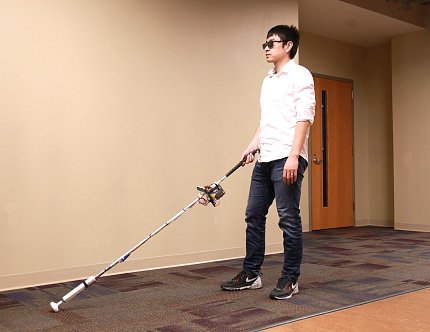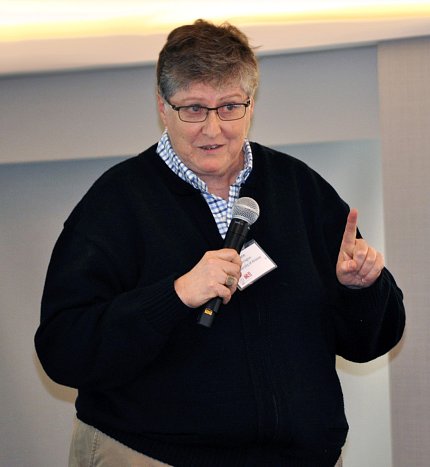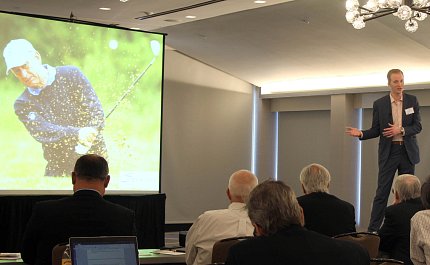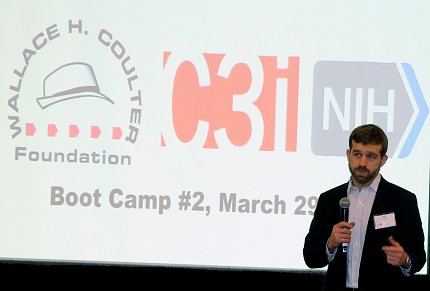The Art of Sealing the Biomedical Tech Deal

Photo: CANG YE, UALR
Could you convince an investor to back a biomedical technology that you invented or designed? Could you make the pitch in 10 minutes or less?
The scenario is reminiscent of a popular television show called Shark Tank, which provides aspiring entrepreneurs with a slender opportunity to make an on-the-spot business deal with dubious investors. For 16 teams of NIH-funded scientists and engineers, transforming scientific savvy into business-oriented value propositions and investment strategies was the challenge each met recently at the end of their intensive 6-month commercialization boot camp.
The teams that came from universities and biotechnology startups from across the country received a research grant from NIH and a supplement to that grant enabling them to join the commercialization course developed by the Wallace H. Coulter Foundation. Each team polished its ideas and presentations over the span of months, then gave its best pitch before a panel of business experts with experience in the commercialization of biomedical technology.

Photo: Lisa Maples
Dr. Jane Carrington made the pitch for a product called the Clinical Event Communication and Management System (CECAMS). She is assistant professor in the College of Nursing at the University of Arizona and described CECAMS as a dashboard for patient health records designed so that any member of the care team can quickly see the status of the patient.
Carrington’s pitch produced a faux deal, but she wasn’t totally satisfied.
“It took 6 months to get to that pitch—and it still needs some work,” she said, explaining that the commercialization course challenged her team to rebrand the tool, from one that would be useful to nurses to one that would help the entire care team. “Ultimately, it pulls information from the electronic health record that otherwise would get lost. The providers—lab, nutrition, nursing, radiology, anybody who comes near that patient—would benefit from this interface.”
The range of biomedical technologies presented during the exercise ran the gamut, from a robotic camera device to improve navigation for the visually impaired, to a one-shot prostate cancer therapy, to a screening and therapy-guidance tool for concussions and other neurological deficits. The concepts that began as a seed idea in the biomedical laboratory each were presented as a marketable product—with a business valuation and identification of the local and global markets. The presenters spoke the language of commerce as well as science and engineering.
The new technologies could have a wide range of health benefits.
Dr. Christopher Drake, director of radiology at Sofie Biosciences, presented an imaging diagnostic tool for cancer immunotherapy.
“What we’re hoping to do is to make sure that the right patients get the right immunotherapy to help them beat their disease,” he said.

Photo: Lisa Maples
David Maine, chief operating officer at DxDiscovery, presented a rapid diagnostic test for fungal nail and hair infections.
“What I hold in my hand is a prototype,” he explained. “You would take a scraping off your nail or your child’s skin, put it in this buffer here, shake it up, put a drop on our test and find out within 10 minutes if you have a dermatophyte infection.”
Each presenter hopes an investor will give his/her product a second look. The investment might be for funds to continue the research phases of product development, including clinical trials, or to scale up and manufacture before launch of a product. In some cases, the next step in product development would be application for additional funding from NIH.
“We have created a partnership with the Coulter Foundation whereby we provide support for NIH-supported investigators to go through this entrepreneurial training course,” said Todd Merchak, program specialist at the National Institute of Biomedical Imaging and Bioengineering. Merchak manages NIBIB’s small business programs, including Small Business Innovative Research and Small Business Technology Transfer grant programs.
Merchak recalled the point 4 years ago when he met with representatives of Coulter and both realized there was a natural alignment of their organizations’ priorities and missions.
“NIBIB’s mission is to improve human health through the development of innovative biomedical technologies,” he said. “Likewise, the mission of the Coulter Foundation is to support the translation of biomedical innovations into products that can help patients.”

Photo: Ray Macdougall
Coulter has supported more than 400 teams of scientists and engineers through the commercialization process. Those teams have produced 35 products on the market; 22 more are now in clinical trials.
The number of NIH-supported teams is steadily growing too, with the goal for NIH of translating more of its funded discoveries into products that will help patients. The cohort practicing pitches this time is the third sponsored by NIH; it included 11 NIBIB-funded teams, along with 3 funded by the National Institute of Neurological Disorders and Stroke and two funded by the National Institute of Diabetes and Digestive and Kidney Diseases.
“We are ramping up a little bit more every year, as we are figuring out ways to promote the program to get more people trained,” Merchak said. “We’ll have 24 teams and 4 institutes participating next year.” The National Heart, Lung and Blood Institute will be the newest NIH sponsor.
Merchak explained that Coulter has curated a network of mentors and business advisors to bolster its curriculum.
“Most of these folks are either former or current entrepreneurs, each of whom has experience in the various market sectors around device development. Some of them are venture capitalists and each has a specific domain expertise,” he said, adding that more important than the curriculum itself is mentoring by those with prior experiences in industry. “That’s really the crux of the program and what we see as the true value added for these teams—to gain insight from people on the front lines who have experienced the commercialization process first-hand.”
